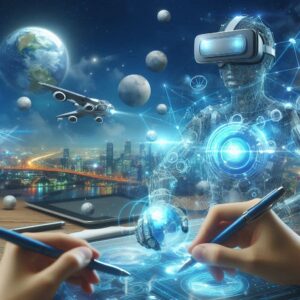Introduction Augmented Reality (AR) is revolutionizing the way we interact with the world around us. By overlaying digital information onto our physical environment, AR enhances our real-world experiences in exciting and innovative ways. From gaming and education to healthcare and retail, AR is making a significant impact across various industries. In this article, we will explore the fundamentals of augmented reality, its applications, and the benefits it offers.

What is Augmented Reality? Augmented Reality is a technology that superimposes digital content, such as images, videos, and 3D models, onto the real world through a device like a smartphone, tablet, or AR glasses. Unlike Virtual Reality (VR), which creates a completely immersive virtual environment, AR enhances the real world by adding interactive and contextually relevant digital elements.
Key Components of Augmented Reality
- Hardware: Devices such as smartphones, tablets, AR glasses, and headsets are used to deliver AR experiences.
- Software: AR apps and platforms enable the creation and deployment of AR content.
- Sensors and Cameras: These components capture the real-world environment and help the AR system understand and interact with it.
- Display: The medium through which AR content is presented to users, such as screens or head-mounted displays.
Applications of Augmented Reality
- Gaming and Entertainment
- Immersive Gaming: AR games like Pokémon GO allow players to interact with virtual characters in the real world, creating an engaging and immersive experience.
- Live Events: AR can enhance live events, such as concerts and sports, by providing additional information and interactive elements.
- Education
- Interactive Learning: AR enables students to visualize complex concepts and interact with 3D models, making learning more engaging and effective.
- Virtual Field Trips: AR can transport students to historical sites, museums, and other locations, providing an immersive educational experience.
- Healthcare
- Medical Training: AR can simulate surgeries and medical procedures, allowing trainees to practice in a safe and controlled environment.
- Patient Care: AR can assist healthcare professionals in diagnosing and treating patients by overlaying digital information onto the patient’s body.
- Retail and E-Commerce
- Virtual Try-Ons: AR allows customers to try on clothes, accessories, and makeup virtually, enhancing the online shopping experience.
- In-Store Navigation: AR can guide customers through stores, highlighting products and providing additional information.
- Industrial and Manufacturing
- Maintenance and Repair: AR can overlay step-by-step instructions and diagrams onto machinery, helping technicians perform maintenance and repairs more efficiently.
- Training: AR can simulate complex industrial processes, providing hands-on training without the need for physical equipment.
Benefits of Augmented Reality
- Enhanced User Experience: AR provides an interactive and immersive experience, making activities more engaging and enjoyable.
- Improved Learning and Training: By visualizing complex concepts and simulating real-world scenarios, AR enhances learning and training outcomes.
- Increased Efficiency: AR can streamline processes and improve productivity in various industries, such as healthcare, manufacturing, and retail.
- Innovative Marketing: AR offers unique and creative marketing opportunities, helping businesses capture the attention of consumers and stand out in a competitive market.
Challenges and Future Prospects While AR holds immense potential, it also faces challenges such as technical limitations, high development costs, and privacy concerns. However, as technology advances and becomes more accessible, these challenges are expected to diminish. The future of AR looks promising, with continuous innovation and integration into various aspects of our daily lives.
Conclusion Augmented Reality is transforming the way we experience the world by blending digital content with our physical environment. From gaming and education to healthcare and retail, AR offers a wide range of applications and benefits. By embracing this technology, we can enhance our real-world experiences and unlock new possibilities.
